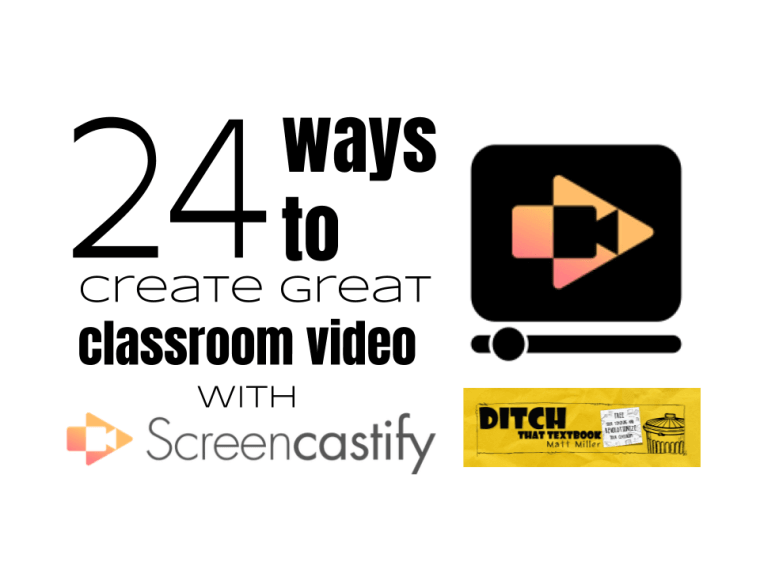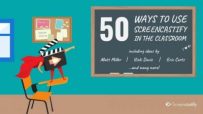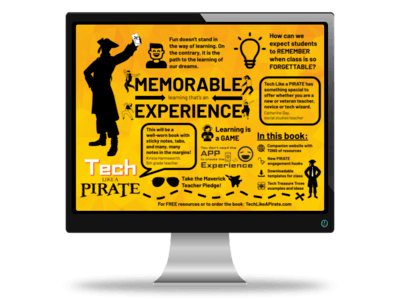
Screencastify makes it easy to record video of your screen or with your webcam. Here are 24 ideas for classroom implementation.
Not too long ago, video creation required bulky, awkward video cameras with big, plastic VCR tapes. Playback required a TV, a VCR and a hope that everything worked nicely together.
And video editing … well, that just wasn’t readily available to the average person.
My, how things have changed.
Everything seems to have a camera these days. Our phones can shoot video and pictures. Our computers, Chromebooks and related devices have webcams on board.
There’s a reason video creation grown so quickly and become so popular. When you watch a video, it creates a connection with the person you’re watching. You hear their voices. You look in their eyes. A bond is created quickly.
Video has never been so accessible to the classroom.
So … what do we do with it?
Why use Screencastify?
One of my favorite classroom video creation tools is Screencastify. It’s a Chrome extension … a little program installed into the Google Chrome web browser in the top right corner.
I love it because you can:
- record video with your webcam OR record what’s happening on your screen.
- record a specific web browser tab, the entire web browser or your computer’s desktop.
- choose between cameras and microphones if you have more than one plugged in.
- include the system audio (sounds the computer makes) or turn them off.
- upload directly to Google Drive or YouTube
Oh, and it’s free! (I’ve only needed the free version, which records up to 10 minutes and puts a Screencastify logo on the screen. The paid version gives extra options, unlimited recording and no logo for $24/year.)
If you use Google Classroom, Screencastify is pure gold. Saving videos to your educational Google Drive account (unlimited storage) and sharing them to Classroom is so easy. (Save video to Drive, add a new announcement/assignment to Classroom, attach video, and you’re done!)
Great Screencastify activities
So … back to that original question. What do we do with the access we have to video creation?
Glad you asked. Here are some ideas that you and your students can start with as soon as you install Screencastify in your Google Chrome web browser:
1. Newscast (webcam) — Students become the news anchor and deliver what they’re learning about as the news of the day. Set them up in front of a whiteboard (or green screen!) with a desk and let them summarize the important details.
2. Moving paper manipulatives (webcam) — Have students draw and cut out paper objects that illustrate the concept they’re learning. Point the webcam at the desk (positioning the computer is tricky but doable!). Then have students describe their idea while using those paper manipulatives to illustrate.
3. Moving digital manipulatives (screencast) — Want to avoid all that paper and cutting? Create digital manipulatives instead. Use Google Drawings, Google Slides or PowerPoint. Use text boxes or pictures as items to move around the screen. Then start a screencast video with Screencastify. Explain what’s happening through the microphone and demonstrate by moving those digital manipulatives around the screen.
4. Whiteboard explainer video (webcam) — Ever seen those RSA Animate videos where they scribble illustrations furiously on a whiteboard? You or your students can make a version of these videos using Screencastify and YouTube to create great videos that show their understanding or teach content. Here’s what you do:
- Plan out your drawings first.
- Record yourself drawing them on a whiteboard using the webcam.
- Save the video to YouTube.
- Use YouTube Creator Studio (click “My Channel”, then “Video Manager”, then “Edit” for the video you want to edit).
- Under the “Enhancements” tab, choose “4x” from the enhancements to speed the video up.
- Under the “Audio” tab, choose a song to play with the video. (Note: If you want to record a voiceover instead, you’d need to use a video editing tool like WeVideo, Windows Movie Maker or iMovie instead.)
5. Tour Builder walking tour (screencast) — Google has this neat tool that lets you create virtual tours using Google Maps. You choose the locations. You choose the view (satellite view from overhead or Street View from the ground). Then you can display it full screen to show others. This fits perfectly with a Screencastify screencast. Have students set up their tours. Then they can record them, narrating with their microphones and showing all the locations they’ve added to their tours. They’re the virtual tour guides!
6. Sub lesson plans (screencast) — If you’ve ever left lesson plans for substitute teachers, you’ve probably felt the frustration of students not following your instructions specifically as you described them. Make sub plans crystal clear with a screencast video, complete with your voice and video of your screen. Then leave that video in Google Classroom (or on a class website with a link), where students can access it and watch it themselves. Looking for even more ways to create better sub plans? Check out this post by Denise Douglas on how to Ditch those sub plans.
7. Animation (screencast) — One of my favorite non-traditional uses of Google Slides is to create stop-motion animation (flipbook animation) by duplicating slides and making slight changes. (See how in this post or watch a great example in this video.) After you’ve created your own animation, record it with a screencast using Screencastify … then bring it into YouTube and use Creator Studio (click “My Channel” then “Video Manager” then “Edit” on your video) to add music to it.
8. Interview (webcam) — Interviewing is a medium that news professionals, talk show hosts, podcasters and more use frequently. People are drawn in to the question and answer format. Students can conduct their own interviews with a laptop/Chromebook and a Screencastify webcam recording. Have them interview each other, teachers, school leaders, family members, veterans on Veteran’s Day, community leaders and more in relation to what they’re learning.
9. Presentations (webcam / screencast) — Oral presentations in front of class are a practice as timeless as education itself. The anxiety over presenting in front of peers goes back that far, too. Recording presentations (with slides or without) using Screencastify provides several benefits:
- That anxiety is eased when there aren’t dozens of eyes watching.
- The presentation can be re-recorded if necessary.
- It helps students watch the amount of time they’re presenting.
- The webcam can record their faces as they speak alongside their slides.
10. Instructional videos (screencast) — In-person, in-class teaching and learning still has tons of advantages. There’s a drawback, though. Once the teacher says it, there’s no rewind button. There’s no pause button. For tricky concepts, recording instructional videos that students can watch later gives them those benefits. Record short videos for your students that they can watch later (or at home with parents when they’re struggling to complete an assignment).
11. Record your class (webcam) — When students are absent from class, they miss a lot. To help them get back on track, you can record class and make it available to them online. Use a Screencastify webcam video to record your instruction. Simply set a laptop or Chromebook up on a stool or desk at the front of the room and start recording. Save the video to your Google Drive and share it with students.
12. Audio assignments (webcam) — So many assignments students do are writing-focused. Change things up by letting them record an assignment with a webcam video. They can be instructed to speak off the cuff, to prepare brief bullet-point notes or to go from a script. This is a great way for foreign language students to practice speaking the new language and demonstrate their skills — by recording a conversation or a monologue in the target language.
13. One question deep dive (webcam / screencast) — Instead of assigning 20 questions or problems for students to work on, what if students only did one — and explained their answer thoroughly? A screencast or a webcam video with a whiteboard lets them dive deep into their thinking and explain their process. Sometimes, when students explain their thinking, it clicks with other students in ways that a teacher explanation does not.
14. Verbal feedback (webcam / screencast) — Written comments from the teacher are quick and easy, and they have their place. Have you considered leaving students oral video feedback? When grading essays, reports or other cumulative projects, teachers can record Screencastify webcam or screencast videos to give more personal feedback. Plus, when they can hear your voice and see your face, those nonverbal and voice intonation clues can show what you really mean when you say “nice job”.
15. Reading test instructions (screencast) — Our teachers use Screencastify to record themselves reading their tests. This is then housed/linked (since it can be saved in your Google Drive) in Canvas or Google Classroom for ANY student (not just those with IEPs and 504s) who would rather have the test read to them than read it themselves. They can stop/start it, go back, etc anytime they want during the test to make sure they are accurately showing their knowledge. Idea submitted by Michelle Brenner.
16. Flip your staff meetings (screencast) — I use Screencastify to flip my staff meetings and front-load information/ideas before a staff meeting. As a principal, I have saved time and our meetings are now focused on conversations/collaboration on given topics. No more housekeeping! Idea submitted Amy Heavin.
17. Post comments in Google Drive (webcam/screencast) — Publishing a video isn’t the end of the creation process. Giving and getting feedback is an important part of video creation. A recent update gives users the ability to post, view and edit Google Drive video comments right from the Screencastify extension.
18. Appsmash with Flipgrid (webcam/screencast) — Flipgrid is an excellent tool that allows you and your students to share webcam videos and interact with each other. Sometimes, you may want students to reference things on their screen. Combining Screencastify and Flipgrid gives you the best of both worlds.
19. Appsmash with Wakelet (screencast) — Wakelet allows students and teachers to easily curate resources. You may want to add a screencast to a collection of resources or have your students add their screencast explaining a digital project to a collaborative collection. Wakelet and Screencastify have teamed up to make it simple to add your videos directly to your collections.
20. Appsmash with Edpuzzle (screencast) — EdPuzzle allows you to add interactive questions to any video and even allows you to prevent viewers from fast-forwarding. So, you can upload your Screencastify video to quickly quiz students on what they are learning as they are watching.
 Screencastify has published a free ebook for educators with 50 ways to use Screencastify in the Classroom. Below are four ideas straight from this incredible resource. Be sure to download the entire ebook for even more great ideas shared by educators and the Screencastify team.
Screencastify has published a free ebook for educators with 50 ways to use Screencastify in the Classroom. Below are four ideas straight from this incredible resource. Be sure to download the entire ebook for even more great ideas shared by educators and the Screencastify team.
21. Teach routines (webcam/screencast) — Throughout the year, it’s important that students are reminded of the routines and procedures of the classroom. You might even have new students you want to quickly integrate into your classroom culture. Creating a Screencastify video detailing important information allows you to remind and inform with ease. (#9/50 pg 9 of the ebook)
22. Dub a video (screencast) — If you’re looking for a creative way to test narration skills, have students mute the audio from a video and add their own voices. You’ll instantly be able to see what type of narrative they create with the visuals on screen. You can even test their ability to speak in a foreign language. (#19/50 pg 23 of the ebook)
23. Parent homework (webcam / screencast) — When students get home and start homework, they may still have some questions. But parents may be just as confused as their children! Recording parent videos to accompany homework ensures that parents are teaching the material at home in the same way that you are teaching it at school. (#44/50 pg 48 of the ebook)
24. Staff PD (screencast) — Learning how to use new ed tech can be so gratifying. But, it’s nearly impossible to teach others in a traditional setting. Create a virtual professional development session, complete with a screencast, to show off the amazing edtech you’re using in your classroom. (#46/50 pg 50 of the ebook)
Want to learn even more about Screencastify? Become a Master Screencaster in this free one-hour certification course taught by yours truly. Whether you are a screencasting newbie or an advanced user this “Master the Screencast” course is appropriate for everyone.

Looking for FREE Tech Like A PIRATE resources?
You’ll find a treasure trove of additional ideas and activities related to the book at TechLikeAPirate.com!
For notifications of new Ditch That Textbook content and helpful links:
Are you looking for quality, meaningful professional learning that both equips and inspires teachers?
Matt provides in-person and virtual keynotes, workshops and breakout sessions that equip, inspire and encourage teachers to create change in their classrooms. Teachers leave with loads of resources. They participate. They laugh. They see tech use and teaching in a new light. Click the link below to contact us and learn how you can bring Matt to your school or district!
Is Matt presenting near you soon? Check out his upcoming live events!



My students created a video with Screencastify where they explained the File menu on Google Slides. They did great videos and this helped them develop their communication skills and diction among other good things!
I want to make longer videos on Screencastify.
[…] 24 ways to create great classroom video with Screencastify […]
[…] out 24 ways to create great classroom video with Screencastify for more […]
[…] Miller, M. (2019, December 9). 24 ways to create great classroom video with Screencastify. Retrieved from https://ditchthattextbook.com/14-ways-to-create-great-classroom-video-with-screencastify/ […]
[…] Instead of answering lots of questions, students can go deep with one question. A screencast video with Screencastify (screencastify.com) can capture that deep dive. Click here to learn how! […]
[…] Screencastify is a FREE Google Add-On that you can use to make videos for your students or you can have them sign up and put the power in their hands. I’ve included a Vlog below showing myself using Screencastify and sharing some of my ideas on how to use it. I also highly suggest that you check out Matt Miller’s Ditch that Textbook blog 14 Ways to Create Great Video with Screencastify in the Classroom […]
[…] videos, or engaging class presentations. You can also make great videos, as you can see on this website which provide 14 ways to make an engaging video to show […]
[…] it more accessible, but we can’t overlook its glaring potential for student use. Check out this blog post for a list of different ideas for using Screencastify in your […]
You mentioned green screen in your newscast suggestion. Have you tried using a greenscreen with Screencastify with any success?
I’ve been using Screencastify for a while now, but am just now trying to start using it with student accounts. One of my teachers has a project in mind and I think this tool will work well. If I can get it to work with a green screen, it will make it even better. The students I’ll be working with are using Lenovos.
Haven’t tried using Screencastify with green screens. Maybe someone reading this comment will have some experience to share. I know there are lots of options out there, though.
nice one https://ditchthattextbook.com
Hi Matt — love the ideas about screencasting. I wanted to make sure you knew about the built-in screencasting tool in WeVideo for Schools. We’ve also built in the ability for students to upload Google Slides in pdf form…we break the pdf into slides so students can add their narrative. We’d like to have a direct import, but Google has no API at this point. Our school version also has chromakey, slo-mo, sound effects, etc. We offer educators a 90-day free trial. Thanks for what you do!
[…] 14 ways to create great classroom video with Screencastify | Ditch That Textbook […]
[…] 14 ways to create great classroom video with Screencastify #edtech #gafechat @jmattmiller ditchthattextbook.com/2016/09/22/14-… […]
I use Screencastify to flip my staff meetings and front load information/ideas before a staff meeting. As a principal, I have saved time and our meetings are now focused conversations/collaboration on given topics. No more housekeeping!
Senor Matt,
Please do a blog post about #5 the Tour Builder. I teach my students directions and would love for them to be able to make their own tour of the town or the school or something, possibly tying in QR codes.
Danke!
Our teachers use Screencastify to record themselves reading their tests. This is then housed/linked (since it can be save in your Google Drive) in Canvas or Google Classroom for ANY student (not just those with IEPs and 504s) who would rather have the test read to them than read it themselves. They can stop/start it, go back, etc anytime they want during the test to make sure they are accurately showing their knowledge.
I LOVE this idea, Michelle. Thanks!